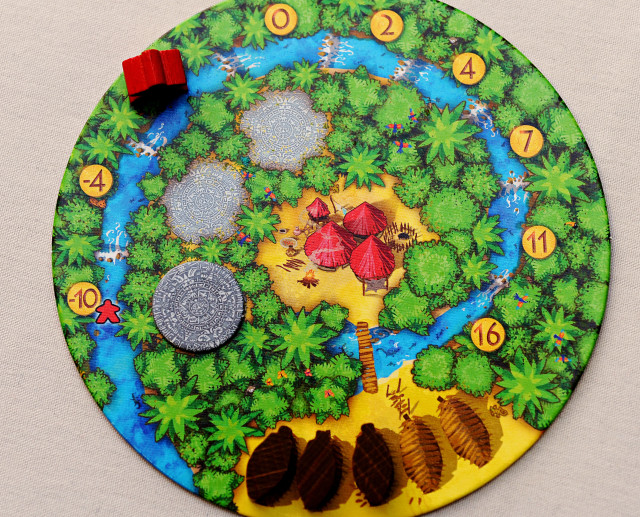I really enjoy tile laying mechanics in games, or as I call them competitive puzzle building. Cacao by Phil Walker-Harding, is one of the latest games to use this style. Players will build plantations, villages, markets and temples all in an effort to grow and sell the delicious bean, responsible for a little thing called chocolate.
Probably the most famous tile laying game out there is Carcassonne and it’s hard not to draw comparisons between it and Cacao. They both have similar size tiles, make use of meeples and have a scoring system based on the landscape that you and your opponents will build together.
In Cacao there are public jungle tiles that everyone has access to and personal tiles that represent your villages. Each player owns an identical set of villages. Everyone starts with a hand of three personal tiles and on their turn they will play a tile and then draw back up. Personal tiles must be placed orthogonally to public tiles and diagonally from other personal tiles. In this way a checker board effect is created between the two types. When an open space is created with two worker tiles it must be filled in with a jungle tile. There is a face-up display of two jungle tiles available and the active player will choose which tile to fill the open space with. The new tile will be activated for current played and also the other player who shares a side with the new tile. In this way you can receive benefits on your opponents’ turns.
You’re often playing both a village tile and jungle tile on the same turn, so where you go and who else you help out has important implications to the game. There is a real tension in how the board develops and it’s hard not to make a move that doesn’t at least create opportunities for your opponents.
Jungle tiles have things like cacao plantations, temples, markets and mines on them. Villages have different workers on each side and so the the way the tile is oriented when they’re placed down is important. For each worker the jungle tile can be activated. So the two workers on the side of a plantation will produce two cacao beans, one worker at a market means you can sell one of those beans at the going rate for money. And money (just as often is the case in real life) is the ultimate goal. Activations can be done in any order, so finding profitable combinations is key to placement.
 Each person starts with their own personal board to hold their cacao beans and places for sun worship. There is also the water fields track. You start with a meeple on the negative ten gold space on the track, but for each worker placed next to water on the board your meeple moves up. You can get yourself out of the negatives and even into the positives, with a potential of 16 gold at the end of the water track.
Each person starts with their own personal board to hold their cacao beans and places for sun worship. There is also the water fields track. You start with a meeple on the negative ten gold space on the track, but for each worker placed next to water on the board your meeple moves up. You can get yourself out of the negatives and even into the positives, with a potential of 16 gold at the end of the water track.
Playing a sun worship tile will allow you to play a village tile on top of another of your own villages. That allows to reactivate all of the surrounding jungle tiles. This can be a great late game move to cash in for easy money. Remaining sun worship tiles are worth one point each at the end of the game.
There are mines in jungle that will be worth a set number of gold multiplied by the workers you send there. It’s a simple way to secure some money. Temple tiles are interesting. They are worth three or six points if you have sent the most or second most workers there. Late game this can steal you some easy points if you’re careful with your placement.
Cacao is a nice light strategy game that would be ideal for introducing new gamers to the hobby, but there’s enough to think about that even seasoned veterans would be charmed by it. Visually it’s really nice to look at. As the jungle takes shape you can imagine your workers trudging off to the market or plantation to bring you back the spoils of their labour. The little wooden cacao beans are pretty cute too.
At last year’s Gathering of Friends convention, the clear favourite game was Splendor. At any given tike there would be 5-10 tables playing it. This year, tastes were more variable. A lot of different games hit the table, but Cacao was definitely up there with the most played of the week. I doubt it will have the same impact that Splendor did, but the two games both have easy mechanics, quick and fun gameplay and high replay value. If you’re a fan of tile laying games like I am, you should definitely venture into the jungle and give Cacao a shot.
Comments
No comments yet! Be the first!